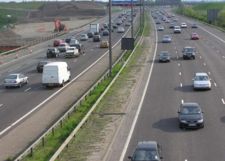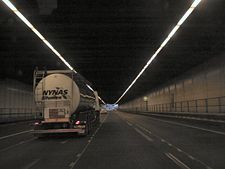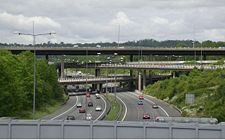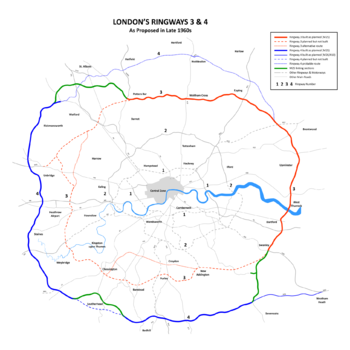M25 motorway
2008/9 Schools Wikipedia Selection. Related subjects: Geography of Great Britain; Road transport
| M25 Motorway | |
 Road of the United Kingdom |
|
| Length | 117 miles (188.3 km) |
| Direction | Circular (London Orbital) |
| Start | Dartford |
| Primary destinations | London Dartford Bromley Sevenoaks Gatwick Airport Reigate Dorking Esher Staines Heathrow Airport Watford Hemel Hempstead Stansted Airport |
| End | West Thurrock |
| Construction dates | 1975 - 1986 |
| Motorways joined | 3 - M20 motorway 5 - M26 motorway 7 - M23 motorway 12 - M3 motorway 15 - M4 motorway 16 - M40 motorway 21 - M1 motorway 23 - A1(M) motorway 27 - M11 motorway |

The M25 motorway is one of the United Kingdom's motorways. It is an orbital motorway, 117 miles (188 km) in circumference, that almost completely encircles London (the gap is formed in the east, with the Dartford Crossing or the A282, linking two sides of the River Thames). It is said to be one of the longest city bypasses in the world . In Europe, the M25 is the second-longest ring road after the Berlin Ring ( A 10) which is longer by 5 miles (8 km).
Description
For most of its length the motorway has six lanes (three in each direction), although there are a few short stretches which are four-lane and perhaps one sixth is eight-lane, around the south-western corner. The motorway was widened to ten lanes between junctions 12 and 14, and twelve lanes between junctions 14 and 15, in November 2005. The Highways Agency has plans to widen almost all of the remaining stretches of the M25 to eight lanes.
It is one of Europe's busiest motorways, with 196,000 vehicles a day recorded in 2003 between junctions 13 and 14 near London Heathrow Airport ( ), which is however significantly fewer than the 257,000 vehicles a day recorded in 2002 on the A4 motorway at Saint-Maurice, in the suburbs of Paris ( ), or the 216,000 vehicles a day recorded in 1998 on the A 100 motorway near the Funkturm in Berlin ( ).
The M25 is not a continuous loop. To the east of London, the toll crossing of the Thames between Thurrock and Dartford is the non-motorway A282. The Dartford Crossing, which consists of two tunnels and the QE2 (Queen Elizabeth II) bridge, is named Canterbury Way. Passage across the bridge or through the tunnels is subject to a toll, dependent upon the type of vehicle. Designating this stretch as a motorway would mean that traffic not permitted to use motorways could not cross the Thames east of Woolwich.
While this is more a structural than a logical issue, at junction 5 near Sevenoaks continuing around the M25 requires the driver to follow the slip roads, as the anticlockwise carriageway continues as the M26 to the east (towards the M20) and the clockwise as the A21 towards the south coast.
The road passes through multiple police force areas. Junctions 1–5 are in Kent, 6–14 in Surrey (passing at places through Greater London and Berkshire), 15–16 are in Buckinghamshire, 17–24 are in Hertfordshire, 25 in Greater London, 26–28 in Essex, 29 in Greater London and 30–31 in Essex. Policing the road is carried out by an integrated policing group made up of the Metropolitan, Thames Valley, Essex, Kent, Hertfordshire and Surrey forces.
The distance of the motorway from central London (taken as Charing Cross) varies from approximately 12 miles (20 km) near Potters Bar to 20 miles (32 km) near Byfleet. In some places (Enfield, Hillingdon and Havering) the Greater London boundary has been realigned to the M25 while in others, most notably in Surrey, it is many miles distant. North Ockendon is the only settlement of Greater London to be outside the M25. In 2004, following a poll, a move was mooted by the London Assembly to entirely align the Greater London boundary to the M25.
The three service areas are located in the central north (JCT 23 South Mimms), south east (Clacket Lane) and central east (Thurrock).
History
The idea of an orbital road around London was first proposed early in the 20th century and was re-examined a number of times during the first half of the 20th century in plans such as Sir Edwin Lutyens and Sir Charles Bressey's The Highway Development Survey, 1937 and Sir Patrick Abercrombie's County of London Plan, 1943 and Greater London Plan, 1944. Abercrombie's plan proposed a series of five roads encircling the capital.
In the post-war years little was done to implement Abercrombie's plans but in the 1960s the Greater London Council developed an ambitious plan for a network of ring roads around the capital. The London Ringways plan was hugely controversial due to the destruction required for the inner two ring roads and the enormous anticipated cost. The plan was modified a number of times to overcome opposition from the residents of threatened areas and the government, but was cancelled in 1973. Parts of the two outer ring roads, Ringways 3 and 4, were begun in 1973 and became the first two sections of the M25 to open in 1975 (junction 23 to junction 24) and 1976 (junction 6 to junction 8).The M16 motorway was the designation planned in the late 1960s and early 1970s for use on Ringway 3, a new motorway planned as part of the London Ringways Plan to run a circular route around London.
Construction of the first section of the M16 began in 1973 between South Mimms and Potters Bar in Hertfordshire and opened in September 1975 with the temporary general purpose road designation A1178. During construction of the first section of the motorway, the majority of the Ringways plan was cancelled and, in 1975 the plans for Ringway 3 were modified to combine it with parts of another motorway, Ringway 4, the outermost Ringway.
The M16 designation was dropped and the combined motorway was given the designation M25 which had originally been intended for the southern and western part of Ringway 4. The section of Ringway 3 west of South Mimms anti-clockwise around London to Swanley in Kent was cancelled and the section clockwise from Potters Bar to the Dartford Tunnel was constructed between 1979 and 1982. The section of Ringway 3 south of the river between Dartford and Swanley was constructed between 1974 and 1977.
Construction of the M25 continued in stages until its completion in 1986. The stages were not constructed contiguously but in small sections, such as Dartford to Swanley (junction 1 to junction 3) and Potters Bar to Enfield (junction 24 to junction 25). As the orbital road developed the sections were linked. Each section was presented to planning authorities in its own right and was individually justified, with almost 40 public inquiries relating to sections of the route. Maps at this time depicting these short sections named the route as the M16 but this changed before completion. The northern sections of the M25 follow a similar route to the World War II Outer London Defence Ring.
The M25 was officially opened on 29 October 1986 with a ceremony by Prime Minister Margaret Thatcher, who opened the section between J22 and J23 ( London Colney and South Mimms).
The initial tenders for the construction of the M25 totalled £631.9 million. This did not include compulsory purchase of land and subsequent upgrades and repairs.
More recently, the perennially congested south-western stretch of the M25 (near Woking) has been fitted with an experimental automated traffic control system called Motorway Incident Detection and Automatic Signalling (MIDAS). This consists of a distributed network of traffic and weather sensors, speed cameras and variable-speed signs that control traffic speeds with little human supervision.
A precursor of the M25 was the North Orbital Road (see A414 road).
Improvements underway
Proposed improvements
Widening
The Highways Agency is proposing to widen 63 miles of M25 from six lanes to eight lanes, from junctions 5-7 and 16-30 at a cost of over £5 billion. The Highways agency offering the contract on a Design, Build, Finance and Operate (DBFO) basis. A shortlist of contractors was announced in October 2006, however contractors were then asked to resubmit their bids in January 2008.
Illuminated sections
Large sections of the M25 are illuminated with the aim of reducing accidents on the road. The current illuminated sections are Dartford to junction 2, junction 5, junctions 6 to 16, junctions 18 to 21A, and junctions 23 to 31. It is thought that when the widening of the M25 is completed junctions 3 to 5 will be the only area unlit, as this is the quietest part of the M25. The type of lights on the M25 varies, with some of the sections using the older yellow low-pressure sodium (SOX) lighting, and others with modern high-pressure sodium (SON) lighting.
Some stretches have recently been upgraded to SON. These include Junction 5, junctions around Heathrow and 27.
Junctions
| M25 Motorway | ||
| Clockwise exits | Junction | Anti-clockwise exits |
| Erith A206 | J1a | Swanscombe A206 |
| Dartford A225 | J1b | No Exit |
| London, Canterbury A2, ( M2), Bluewater Dartford (A225) |
J2 | London, Canterbury A2, (M2), Bluewater |
| London (South East) A20 Maidstone M20 Swanley B2173 |
J3 | Maidstone, Channel Tunnel, Dover M20 London (South East), Swanley A20 |
| Bromley A21 Orpington A224 |
J4 | Bromley A21 Orpington A224 |
| Maidstone, Channel Tunnel, Dover M26 (M20) Sevenoaks, Hastings A21 |
J5 | Sevenoaks, Hastings A21 |
| Clacket Lane services | ||
| East Grinstead, Eastbourne, Caterham, Godstone A22 Westerham ( A25) |
J6 | East Grinstead, Eastbourne, Caterham, Godstone, A22 Redhill (A25) |
| Gatwick Airport, Crawley, Brighton, East Grinstead, Croydon M23 | J7 | Gatwick Airport, Crawley, Brighton, Croydon M23 |
| Reigate, Sutton A217 Redhill (A25) |
J8 | Reigate, Sutton A217 Kingston ( A240) |
| Leatherhead A243 Dorking ( A24) |
J9 | Leatherhead A243 Dorking (A24) |
| London (South West), Kingston, Guildford, Portsmouth A3 | J10 | London (South West), Guildford A3 |
| Chertsey A317 Woking A320 |
J11 | Woking A320 Chertsey A317 |
| Basingstoke, Southampton, Richmond M3 | J12 | Basingstoke, Southampton, Richmond M3 |
| Staines A30 | J13 | London (West), Staines, Windsor A30 |
| Heathrow Airport (Terminals 4, 5 and Cargo) A3113 | J14 | Heathrow Airport (Terminals 4, 5 and Cargo) A3113 |
| The WEST, Slough, Reading, London (West), Heathrow Airport (Terminals 1, 2 and 3) M4 | J15 | The WEST, Slough, Reading, London (West), Heathrow Airport (Terminals 1 2, and 3) M4 |
| Birmingham, Oxford, Uxbridge, London (West) M40 | J16 | Birmingham, Oxford, Uxbridge, London (West) M40 |
| Maple Cross ( A412) | J17 | Maple Cross, Rickmansworth (A412) |
| Rickmansworth, Chorleywood, Amersham A404 | J18 | Chorleywood, Amersham A404 |
| No Exit | J19 | Watford A41 |
| Hemel Hempstead, Aylesbury A41 | J20 | Hemel Hempstead, Aylesbury A41 A4251 |
| The NORTH, Luton & Airport M1 | J21 | The NORTH, Luton & Airport M1 |
| Watford A405 Harrow (M1 South) |
J21A | St Albans A405 London (North West) (M1 (South)) |
| St Albans A1081 | J22 | St Albans A1081 |
| Hatfield A1(M) London (North West) A1 Barnet A1081 South Mimms services |
J23 | Hatfield A1(M) London (North West) A1 Barnet A1081 South Mimms services |
| Potters Bar A111 | J24 | Potters Bar A111 |
| Enfield, Hertford A10 | J25 | Enfield, Hertford A10 |
| Waltham Abbey, Loughton A121 | J26 | Waltham Abbey, Loughton A121 |
| London (North East), Stansted Airport, Harlow, Cambridge M11 | J27 | London (North East), Stansted Airport, Harlow, Cambridge M11 |
| Chelmsford, Witham, Colchester A12 Brentwood A1023 |
J28 | Chelmsford, Romford A12 Brentwood A1023 |
| Romford, Basildon, Southend A127 | J29 | Basildon, Southend A127 |
| Thurrock ( Lakeside), Tilbury A13 Thurrock services |
J30 | Dagenham, Thurrock (Lakeside), Tilbury A13, ( A1306, A126, A1090) Thurrock services |
| South Ockendon, Dagenham A1306 | J31 | No Exit |
Map
Racing
The orbital nature of the motorway, in common with racetracks, lent itself to unofficial, and illegal, motorracing. At the end of the 1980's, before the advent of speed enforcement devices, owners of supercars, many employed in the financial service industry in the City and in Docklands, would meet at night at services stations such as South Mimms and conduct time trials. Times below 1 hour were achieved; an average speed of over 117 mph (188.3 km/h), which included coming to a halt at the Dartford Tunnel toll payment booths.




